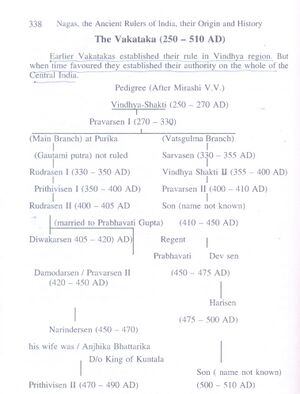Wasim
| Author:Laxman Burdak, IFS (Retd.) |

Washim (वाशिम), also called Vatsagulma, is a city and district in Maharashtra. Washim was known earlier as Vatsagulma and it was the seat of power of the Vatsagulma branch of Vakataka dynasty. Sarvasena (330-355 AD), the Second son of Pravarsena I, was the founder of Vatsagulma branch.
Variants
- Wasim (वासिम)
- Vatsagulma (वत्सगुल्म)
- Vashima/Vashim वाशिम = vasim वासिम (AS, p.846)
- Washim वाशिम (AS, p.846)
- Vasim वासिम, जिला अकोला, बरार, महा, दे. Vanshagulma वंशगुल्म (AS, p.847)
- Vanshagulma वंशगुल्म (AS, p.828)
- Vachchhoma (Pali)
- Padmatirtha पद्मतीर्थ (AS, p.524)
Location
Etymology
Washim was known earlier as Vatsagulma and it was the seat of power of the Vakataka dynasty. Sarvasena the Second son of Pravarsena I was the founder of Vatsagulma or Washim of today. His fourth generation, Harishena was one of the main patrons of the Ajanta Caves World Heritage Site. The house of Vakataka & their last generations supported Buddhism and supported all Buddhist arts.
History
Washim, is the same place where Vatsa rishi performed penance and where many Gods came to bless him as a result of which it came to be known as Vatsagulma. Its mention as Vatsagulma is traced in Padma. In the Treta Yuga, the second age, this country was a part of the Dandakaranya, or Dandaka jungle, and the rishi Vatsa had his ashram hermitage at this place. Vakatakas which is known as the Vatsagulma branch of the Vakatakas. The existence of this branch of the Vakatakas was unknown until the discovery of the Washim plates in 1939. The founder of this family was Sarvasena mentioned in the Washim plates as the son of Pravarasena I. Sarvasena made Vatsagulma i.e. Washim, the capital of his kingdom. In course of time the place became a great centre of learning and culture. It was, however, known as a holy place long before it became the capital of Sarvasena who flourished in the period circa A. IV 330-355. He was followed by Vindhyashakti II. A reference to Washim is found in Kavyamimansa by Rajashekhara, the celebrated poet and dramatist of the Yayavara family who flourished from 875 to 925 AD. He has mentioned therein Vatsagulma as situated in Vidarbha. But even earlier references to Vatsagulma or Vatsa-gulma are found in Mahabharata and Kamasutra, which in their present form are assignable to a period before the age of the Vakatakas. The Karpuramunjari, a play written by Rajashekhara and staged at Kanauj under the patronage of the Gurjara-Pratiharas also mentions it as situated in the Daksina-patha (Deccan). Vachchhoma (Vatsagulma) was the name of the Prakrit style current in Vidarbha. Vashima is derived from Vachchhoma the Prakrit name of Vatsagulma. The Sanskrit treatise Vatsagulmyamahatmya also gives traditional information about this town.
पद्मतीर्थ
पद्मतीर्थ (AS, p.524) - वासिम (महाराष्ट्र) के परिवर्ती क्षेत्र का प्राचीन नाम पद्म तीर्थ कहा गया है. किंवदंती है कि वासिम में वत्स ऋषि का आश्रम था.[2]
वंशगुल्म
विजयेन्द्र कुमार माथुर[3] ने लेख किया है....वंशगुल्म (AS, p.828): वंशगुल्म विदर्भ का एक प्राचीन तीर्थ स्थान था। इस तीर्थ का उल्लेख महाभारत, वनपर्व 85,9 में इस प्रकार है- 'शोणस्य नर्मदायाश्च प्रभवे कुरुनंदन, वंशगुल्म उपस्पृश्य वाजिमेधफलं लभेत्।' उपरोक्त वर्णन में वंशगुल्म तीर्थ की स्थिति अमरकंटक के निकट सिद्ध होती है। प्राचीन काल में विदर्भ का इस स्थान तक विस्तार था तथा वंशगुल्म में इस देश की राजधानी थी। वंशगुल्म स्थान का अभिज्ञान 'वासिम', मध्य प्रदेश से किया गया है।
Medieval History
During the middle of the 18th century Washim was the famous centre of cloth production along with Balapur. A village in Washim district called Wara Jahangir had Brahmin Jahgirdar named Raje Udaram Deshmukh who was a companion of Maloji Raje Bhonsale. Also his wife named Raibagan helped Shivaji secretly at Shaista Khan's time. It is clearly brought out by one of the articles of the treaty of Kanakpur entered into between Janoji Bhonsle and the Peshwa Madhavrao I after the battle between the two in 1769. The article states that the Bhosles should send annually to the Peshva cloth manufactured at Washim and Balapur worth Rs. 5,000. A mint was also in existence at Washim. The town was looted by the Pendharis in 1809 along with some other places inBerar.
When in 1768-69, the Peshva attacked the Bhosle, his army had come from Aurangabad through the pass to Washim from which place it moved forward on its expedition. Afterwards it was decided that the Peshva Madhavrav and Janoji Bhosle should meet at Washim and accordingly the terms of the treaty were finalised there and the treaty was signed at Kanakpur. The temple of Balaji at Washim was constructed by Bhavani Kalu who was the Divan of Sabaji Bhosle.
However, before the establishment of the Vakataka rule with Washim as their capital, the place was an important center from the religious point of view and it even now contains many old temples and tirthas which are revered by the people.
References
Back to Mahabharata Places

